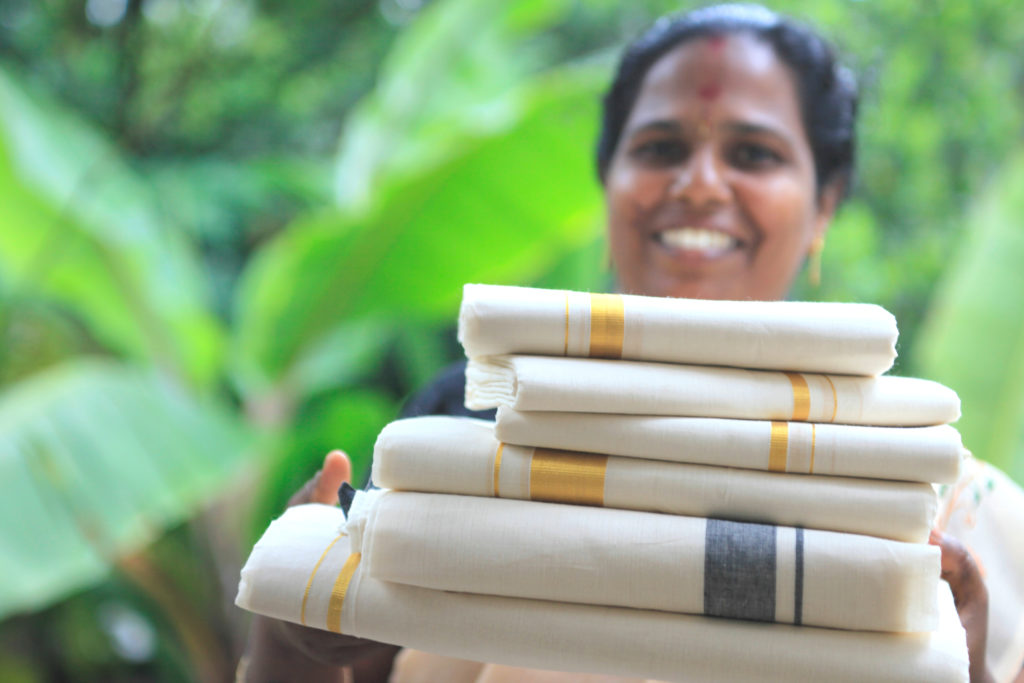Author – Meena Wells

If you’ve ever been to a cultural event in Kerala or to a Malayali wedding, you would have noticed the unique Kerala sarees and mundus with a kasavu (gold zari) border. Kerala is known for its mundus and the Kerala saree, which are typically undyed cotton fabrics with color or kasavu (gold zari) borders and a kasavu stripe on the pallu. There are several regional variants in Kerala kasavu sarees, which have a few notable differences between them if you look closely at the fabric as well as the techniques used.
Basically there are four main centres for weaving the traditional handlooms of Kerala – Balaramapuram, Kuthampully, Chendamangalam, and Kasaragod. These centres specialize in the plain cotton designs with kasavu or half-fine zari border, while Kasaragod adopts simple patterns and colours. These textile designs have been given geographical indication tags (GI tags) to give importance to their uniqueness in Indian handloom sector.
Balaramapuram textiles (Thiruvananthapuram district)

Balaramapuram, being best-known places in Kerala for handloom, perhaps holds the monopoly over the traditional kasavu mundu (white cotton dhotis) and settu mundu (or mundum neriyathum). The tradition of weaving in Balaramapuram owes its patronage to the royal family of Travancore, which dates back to the end of the 18th century when Maharaja Balarama Varma brought weavers from what is now Valiyur in Tamil Nadu to weave clothing for the royal family.
Traditional Balaramapuram textiles have a gold zari border and usually a simple zari stripe at the end, and are typically woven from natural cotton yarn. Recently, experiments have been done with the patterns, such as weaving the same designs using coloured yarn for the weft, and the increasingly popular mural painting sarees – where fabric paints are used to recreate traditional Kerala temple art on the pallu of the saree. Given the light weight and coarse texture of the cotton fabric, these textiles are ideal for the warm and humid climate in Kerala.
Chendamangalam textiles (Ernakulam district)

The array of handloom fabrics woven in Chendamangalam is much the same as what one finds in Balaramapuram, but with less emphasis on kasavu patterns. Instead, the typical Chendamangalam mundu or settu mundu has coloured borders with a matching colour stripe, with only small amounts of kasavu for ornamentation. Like in other parts of Kerala, weavers in Chendamangalam were under official patronage of the feudal family of Paliam, who served as the chief ministers for the Rajas of Cochin. In terms of the actual process, Chendamangalam textiles are woven on frame looms, and their texture is slightly heavier than what one would find in the same types of fabrics from Balaramapuram.
Kuthampully textiles (Thrissur district)

While Balaramapuram and Chendamangalam are known for traditional designs for mundus and sarees, Kuthampully sarees are the most visible style outside the state. These sarees are quite popular in Kerala as well, given the variety of jacquard designs that they are typically ornamented with – setting them apart from sarees woven elsewhere in the state. Since Kuthampully sarees are typically woven using half-fine zari, this keeps down on the cost of the final product and adds to its popularity. Another uniqueness of this design is that the kasavu border does not extend all of the way to the border, and this gap is white.
Like most other places in Kerala, the sarees woven here are generally off-white in colour, owing to the use of undyed cotton yarn. Kuthampully weavers have their roots in the Devanga Chettiar community from Mysore. They came under the patronage of the Kochi royal family, and originally had woven fabrics exclusively for the members of the palace – much like the weavers from Balaramapuram.
Kasargod textiles (Kasaragod district)

There’s not a whole lot of difference in terms of design between the sarees woven in Kasargod and those woven in Mangalore – technically it’s the same design for the most part, which is woven all the way from Kannur to Mangalore. Kasaragod’s weavers are originally from the Padmashaliya community, who were originally from Mysore. Surprisingly, there seems to be much more interest in the Kasargod saree than its counterpart in Mangalore. Kasargod sarees have got a GI tag while Mangalore sarees do not despite Karnataka having more GI products than any other state.
Kasargod sarees are the notable exception to the popular image of the Kerala saree being natural cotton and decorated with kasavu – instead, a variety of colours are popular and there is a lack of any zari ornamentation. Having said that, the design aesthetic remains relatively simple, much in line with what one would expect of the relatively sober preferences in Kerala. Vat dyes are commonly used for Kasaragod sarees, owing to the colour fastness as compared to most other commercially available dyes.
Other Centres for Handloom in Kerala
In addition to these places of traditional textiles, there are a few other centres for handloom in Kerala. Kannur manufactures a good deal of handloom running fabrics but few sarees, and this is typically done on frame looms. Palakkad is known these days for handloom sarees, but the style woven there typically bears more resemblance to those woven in Bengal than elsewhere in Kerala. There are even a few places where sarees with ikat patterns are woven, reminiscent of some of the simpler designs from Orissa and Telangana, but by and large most of the designs woven in Kerala are of the traditional varieties of mundus and sarees, with minor variations from the types woven at Balaramapuram, Chendamangalam, and Kuthampully.






Hi how can contact the author
Very nice and informative